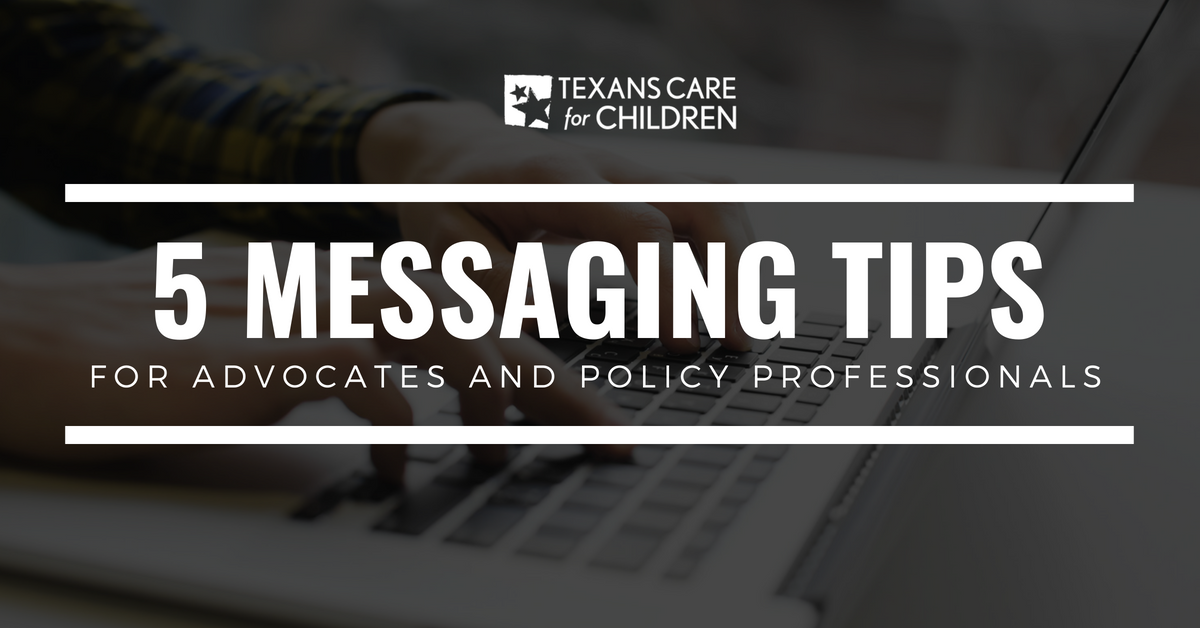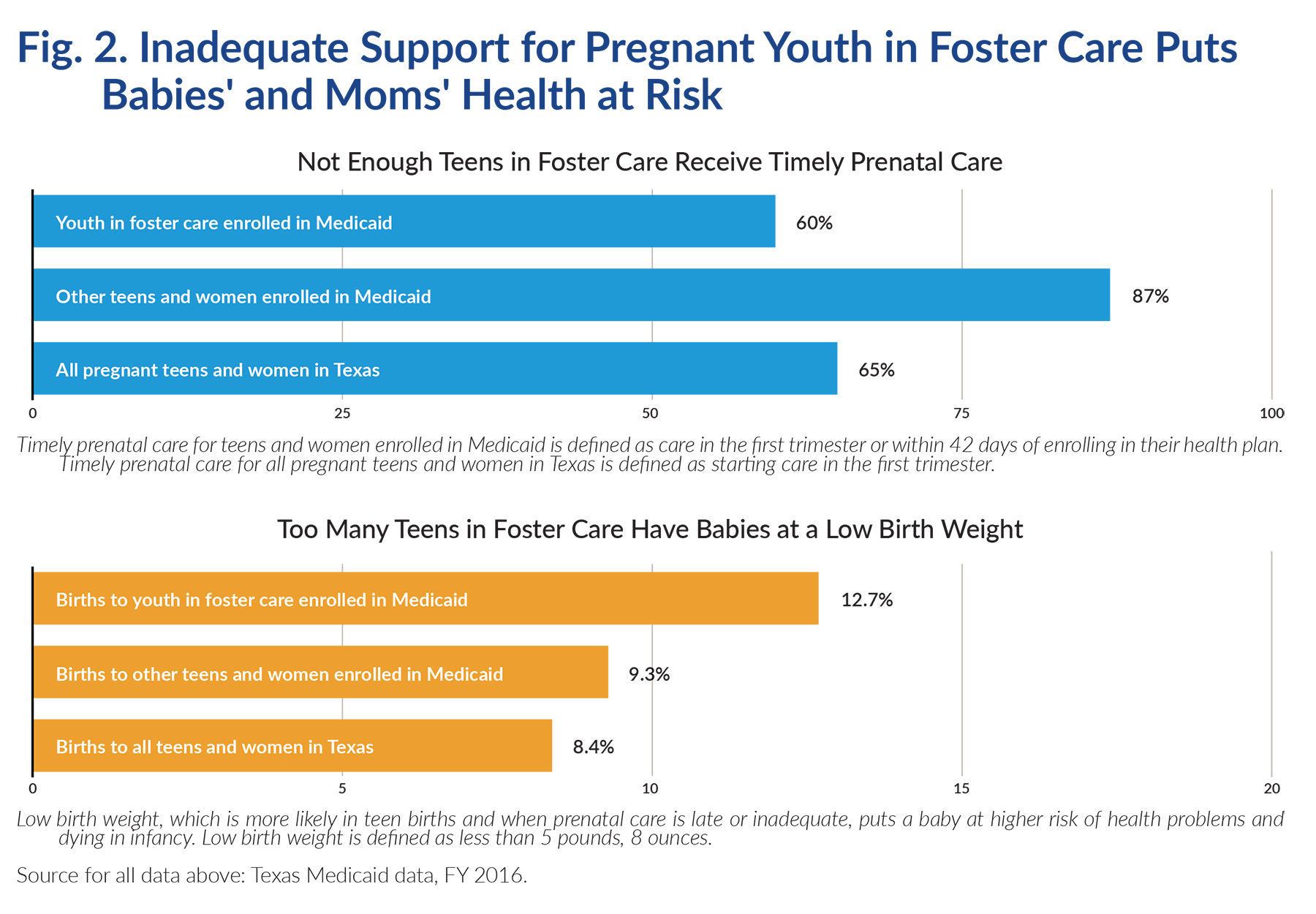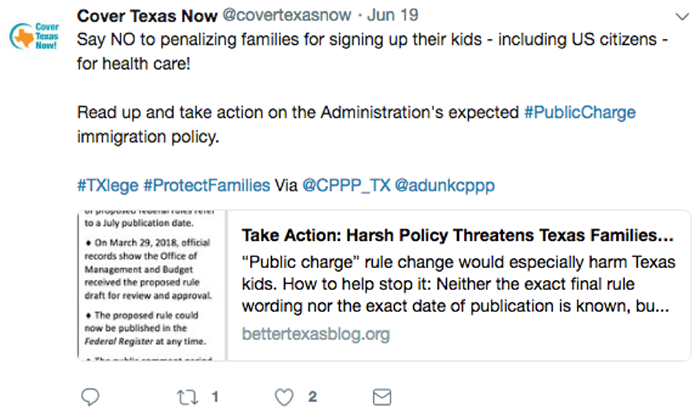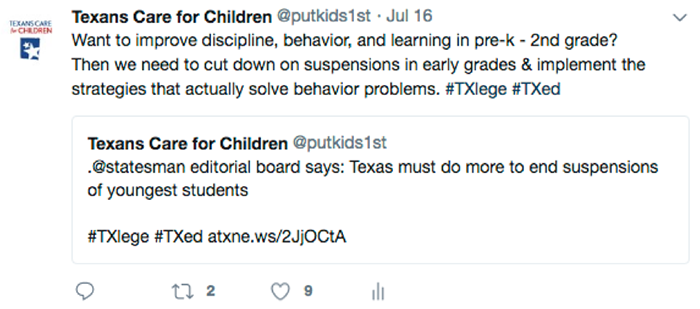Since I became the Communications Director at Texans Care for Children in 2014, I’ve had the opportunity to attend communications trainings, read up on messaging research and best practices, and realize some of the things I was doing wrong during the previous 15 years that I spent communicating publicly about policy issues.
Most people don’t have the time to dig into that research or spend two days at a conference in Omaha learning to communicate effectively about policy issues. So let me share with you my interpretation of some of the key tips that the experts have shared with me and that I try — not always successfully — to follow.

1. WHEN YOU TRY TO REFUTE MISINFORMATION, PEOPLE WILL FORGET THAT YOU SAID “NOT” OR “FALSE” OR “IT’S A MYTH.”
Our brains kind of ignore the word “not” and other words that signal that something is false. And that fact, explained here by the messaging experts at Topos Partnership, is really relevant to policy advocacy.
Imagine a reporter asks you, “I’ve heard that the Good Stuff for Kids Program is broken. Is that true?”
Well, if the program functions well, you are better off answering, “The Good Stuff for Kids Program is really effective” or “The Good Stuff for Kids Program is doing a great job helping Texas children.”
What happens if you say, “The research shows that the Good Stuff for Kids Program is not broken” or “Some people recently said the Good Stuff for Kids Program is broken, but that’s false” or “It’s a myth that the Good Stuff for Kids Program is broken”?
If you say that, people will associate the program with the word “broken.”
In other words, if you’re on one side of a policy debate, then don’t repeat the other side’s talking points – even if you’re saying their talking point is false.
Once you start thinking about this concept, you’ll realize it comes up over and over again in different parts of our lives.
For example, instead of telling the kids, “Come on, the broccoli isn’t gross,” you might start by saying, “Hey guys, this broccoli is actually pretty tasty with this melted cheese on it.”
Or if the Watergate scandal is bringing down your presidency and you want the American people to think you’re innocent, then tell them you’re innocent. Don’t announce, “I am not a crook!”
2. AVOID “NAKED NUMBERS.” SAY WHAT YOUR NUMBERS MEAN.
If I just tell you that a candidate raised $1 million in the last quarter of the year, you may interpret that number differently than I intended it, or it might not mean anything to you at all.
Instead of presenting naked numbers (a term I’ve heard from researchers at Frameworks and others), make your point and then follow it up with numbers or other evidence to back it up.
If I tell you that the candidate raised more than she did in the last quarter or three times more than her opponent raised during the same quarter or less than other candidates have historically raised, then the number starts to take on some meaning and serve as evidence for the point I’m trying to make.
Want a quick test to know whether you are using naked numbers?
When you say “12 percent” or “150,000 kids” or “$200 million” in your graph, chart, blog, testimony, social media post, presentation, report, or op-ed, ask yourself this question:
Will everyone get the point even if they ignore the numbers? If the answer is “no,” then you have naked numbers and need to fix it.
Avoiding naked numbers is an example of a more fundamental messaging concept of making an assertion and then backing it up with evidence, an example, or an illustration.
For example, when you get that question we mentioned above about whether the Good Stuff for Kids Program is broken, you might respond: “The Good Stuff for Kids Program does a great job of helping kids in school. Research shows that children who complete the program are 20 percent more awesome by 9th grade.”
Quick check: Does the audience get the message if we cross out the numbers? Yes. No naked numbers here.
Finally, to give you one more example of how to avoid naked numbers, here’s how we labeled a graph in a recent report to make clear what the numbers were saying:

3. START WITH SHARED VALUES, GOALS, AND EXPERIENCES – AND BE SURE TO OFFER A SOLUTION TO THE PROBLEM.
Many advocates have adopted the Opportunity Agenda’s suggestion to build a message in this order:
- Value: A value (or goal) that you and your audience have in common – more on this in a moment.
- Problem: What’s the threat to the shared value? (In other words, what’s the reason the audience should care about this issue?)
- Solution: What’s the solution to the problem? (Ideally one that is proportional to the problem.)
- Action: What should your audience do? (I sometimes combine this with the Solution.)
This approach works whether you’re crafting a social media post, testimony to lawmakers, a policy brief, an op-ed, an answer to a reporter’s question, or something else that delivers a message.
Including a solution in your message is particularly important. If you don’t, your audience may become fatalistic about this problem and move on to something else.
But the most critical part of this formula may be step one: starting with shared values. When applying it to my work on a day-to-day basis I tend to define it a little more broadly to include shared goals or a shared vision.
When you introduce an issue by highlighting a goal or goals that you share with the audience, you’re both connecting with the audience and framing the issue in an effective way.
To put it another way, you’re starting the conversation by telling your audience that something they care about is at stake. (Of course, you’ll need to know who your intended audience is and what their values or goals are.)
Here’s an example from Representative Jeff Leach in which he brings in the audience by appealing to our sense of fair treatment for teachers and then pivots to his particular policy solution:

And here’s an example from Cover Texas Now that frames the issue and connects with the audience before asking them to pay attention to an important but wonky issue (imagine how much less compelling the message would be if we deleted the first sentence):

Here’s one final example. We have worked to reduce suspensions of kids in pre-k through second grade. Some people have questioned whether those suspensions should be reduced, saying that discipline is important in early grades. The following tweet starts off by making clear that we share the goal of improving discipline and behavior.

4. USE CAUTION WHEN TELLING AN INDIVIDUAL’S STORY, AND CONNECT IT TO THE POLICY YOU’RE TRYING TO CHANGE.
There’s no doubt that telling anecdotes and introducing real individuals affected by policies helps to get the attention of policymakers and others, but it also has its downsides, as Frameworks explains here.
Our audience may pick apart the details of the story, find a reason to blame that individual for the problem, or simply not feel any connection to the individual in the story. Even if it’s a story of someone doing something positive, our audience may react by thinking we just need more people to “step up” like the person in the story did.
Either way, the audience is now thinking on the level of individual action. If we’re trying to change policy, we need to get them thinking at the policy level.
Navigating the tension between our need for storytelling and the risks of storytelling is tricky. The best suggestions seem to be to avoid overemphasizing individual stories, be thoughtful about selecting and narrating those stories, and keep the focus on the big picture policy issues as much as possible. Here’s an example of how to do that.
One way to avoid some of the pitfalls and bring the story closer to the policy level is to tell the story of a “middle man.” For example, in some cases telling the story of a staff member at a homeless shelter may be more effective than telling the story of an individual staying at the shelter.
And just as we want to introduce a policy issue by highlighting values or goals that we share with our audience, we should introduce a “real person” by highlighting experiences or characteristics that they share with our audience rather letting our audience subconsciously think of the real person as fundamentally different and “other.”
5. WE NEED TO POINT OUT RACIAL DISPARITIES AND DISPROPORTIONALITY WITHOUT ACCIDENTALLY REINFORCING STEREOTYPES.
It’s important to talk about race and equity, but we need to be smart about it – and make sure our message doesn’t backfire and have unintended consequences.
When we point out that children of color are disproportionately suspended or arrested, or that black women face a higher risk of dying during or shortly after childbirth, it might be clear to us that implicit bias, institutionalized racism, public policies, and other reasons explain these statistics.
Unfortunately, our audience may react to those statistics by blaming children of color and black women.
As The Opportunity Agenda says, “Don’t lead with evidence of unequal outcomes alone—which can sometimes reinforce stereotypes and blame.”
To raise these issues effectively, several of the concepts noted throughout this blog are key.
Once again, we need to avoid naked numbers. As Frameworks explains, “When presenting data on disparities, never leave the interpretation of those statistics up to chance. Proactively point the public to the meaning you wish to convey with the data.”
In other words, we have to point out that the numbers show disparities (to avoid naked numbers), but that alone is insufficient.
We also have to explain why those disparities exist and prevent our audience from reaching the wrong conclusion.
Sequencing matters too, as we talked about in the section above on starting a message with shared values or shared goals. Before we bring up an equity problem in a particular policy area, we can start the conversation by getting our audience on board with the notion that there is a problem in that area, whether it’s school discipline practices, maternal mortality, or cuts to Early Childhood Intervention (ECI) services that affect people from all backgrounds.
Once they recognize there’s a problem with the broader policy issue, they should be more receptive to hearing about racial disparities in that policy issue without blaming people of color. If we start with racial injustice, on the other hand, we may lose people.
The Opportunity Agenda’s overview of criminal justice reform serves as an example, starting with the problems in the system and then introducing the issue of racial disparities.
They explain the sequencing concept this way: “Opening conversations with values like opportunity helps to emphasize society’s role in affording a fair chance to everyone. But starting conversations here does not mean avoiding discussions of race. We suggest bridging from shared values to the roles of racial equity and inclusion in fulfilling those values for all.”
Finally, to effectively communicate about equity, we need to quickly offer solutions, as noted earlier. Frameworks says, “A common sub-theme is that people are unable to see practical solutions to the race question….When people are presented with effective solutions, they are able to more clearly understand where the system breaks down and how we might fix it.”



